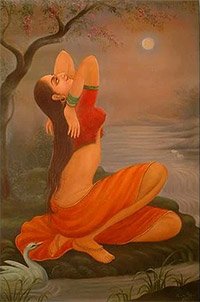Vrikshayurvedayoga, Vṛkṣāyūrvedayoga, Vrikshayurveda-yoga: 1 definition
Introduction:
Vrikshayurvedayoga means something in Hinduism, Sanskrit. If you want to know the exact meaning, history, etymology or English translation of this term then check out the descriptions on this page. Add your comment or reference to a book if you want to contribute to this summary article.
The Sanskrit term Vṛkṣāyūrvedayoga can be transliterated into English as Vrksayurvedayoga or Vrikshayurvedayoga, using the IAST transliteration scheme (?).
In Hinduism
Kama-shastra (the science of Love-making)
Source: Shodhganga: Elements of Art and Architecture in the Trtiyakhanda of the Visnudharmottarapurana (kama)Vṛkṣāyūrvedayoga (वृक्षायूर्वेदयोग) refers to “horticulture and gardening” and represents one of the “sixty four kinds of Art”, according to the Kāmasūtra of Vātsyāyaṇa.—Indian tradition, basically includes sixty four Art forms are acknowledged. The references of sixty four kinds of kalā are found in the Bhāgavatapurāṇa, Śaiva-Tantras, Kāmasūtra of Vātsyāyaṇa etc.

Kamashastra (कामशास्त्र, kāmaśāstra) deals with ancient Indian science of love-making, passion, emotions and other related topics dealing with the pleasures of the senses.
See also (Relevant definitions)
Partial matches: Vrikshayurveda, Yoga.
Query error!
Full-text: Horticulture, Gardening, Vrikshayurveda.
Relevant text
Search found 6 books and stories containing Vrikshayurvedayoga, Vṛkṣāyūrvedayoga, Vṛkṣāyūrveda-yoga, Vrikshayurveda-yoga, Vrksayurvedayoga, Vrksayurveda-yoga; (plurals include: Vrikshayurvedayogas, Vṛkṣāyūrvedayogas, yogas, Vrksayurvedayogas). You can also click to the full overview containing English textual excerpts. Below are direct links for the most relevant articles:
Soundarya Lahari of Shri Shankara (Study) (by Seetha N.)
The Sixty-four Tantras and Sixty-four Arts < [Chapter 7 - Philosophical aspects in Saundaryalahari]
Vishnudharmottara Purana (Art and Architecture) (by Bhagyashree Sarma)
3. A General Note on Art < [Chapter 1 - Introduction]
Kamashastra and Classical Sanskrit literature (study) (by Vishwanath K. Hampiholi)
Chapter 1.3 - The supplementary Arts and Sciences < [Chapter 2 - Kamasutra part 1 (Sadharana-adhikarana)—Critical study]
Shringara-manjari Katha (translation and notes) (by Kumari Kalpalata K. Munshi)
Bhaktavijaya: Stories of Indian Saints (by Justin E. Abbott)
Hindu Architecture in India and Abroad (by Prasanna Kumar Acharya)